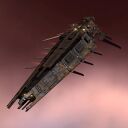User:Breeze one/sandbox2
Template:FCC Links Template:FCC Doctrine Links
Contents
FCC Hurricanes
| The Artillery Hurricane has been a staple of EVE for almost as long as the game has existed, and continues to shine even now, as a mainline doctrine for groups such as Pandemic Horde. The Doctrine is essentially the Artillery Ruptures taken to their highest degree, focusing on Alpha strike to remove ships from the field even in the face of overwhelming Logistics support
The Uni’s own FCC Hurricanes were designed and chosen as a FCC Doctrine by the FCC candidates of 2017 |
Template:FCC Links Template:FCC Doctrine Links
FCC Hurricanes
| The Artillery Hurricane has been a staple of EVE for almost as long as the game has existed, and continues to shine even now, as a mainline doctrine for groups such as Pandemic Horde. The Doctrine is essentially the Artillery Ruptures taken to their highest degree, focusing on Alpha strike to remove ships from the field even in the face of overwhelming Logistics support
The Uni’s own FCC Hurricanes were designed and chosen as a FCC Doctrine by the FCC candidates of 2017 |
Implementation
Like Ruptures and Thrashers, Artillery Hurricanes are all about the alpha strike. A good Hurricane pilot can reach 2-3k damage in a single volley, with a range of up to 60km. This lets you delete ships at range before their logistics wing can apply their repairs to a targeted ship. This is particularly useful when facing a fleet with an overwhelming Logistics support wing, which you would be unable to break through with more sustained damage doctrines such as FCC Feroxes
Naturally however, to reach this stage, Hurricanes rely on numbers to achieve a large enough alpha strike. Rough numbers would be 20 Hurricanes to safely volley off enemy T1 Cruisers, and around 50 to volley off similar Battlecruisers or T3 Cruisers. Bear in mind as well that you will lose ships through the fight as well, and some additional buffer of ships is needed to maintain a sufficiently high alpha strike through a fight
In a sustained battle, your tank and DPS is comparably weak versus equivalent doctrines such as Feroxes, so if you do not have the ships to volley opponents off the grid quickly, then skirmish tactics become the order of the day. You are fairly fast and agile for your size, so it remains a valid tactic to use tactical warps to pick off smaller, weaker support ships in the enemy comp without fully committing to a fight, potentially weakening them for a full on assault, or alternatively just satisfying yourself with these harassment tactics
For the Uni, while fleets of 50+ is achievable for special events, 20-30 is your usual roaming fleet size, so FCC Hurricanes for the Uni are unlikely to be picking fights with other Battlecruiser fleets. Instead they can be used to devastate smaller ships. Fleets of T3 Destroyers such as Jackdaws, or T1 Cruisers such as Rail Moas or Caracals are prime targets for a fleet such as this
Having said this, while your tank and sustained DPS may be lacking, if you have a numbers or tactical advantage, then you can still successfully fight a pitched battle, particularly with sufficient logistics support, albeit the Hurricanes do not shine in such an engagement Like most long range doctrines, anchoring on the FC or a designated DD Anchor is optimal, and given the awful tracking of Artillery, the anchor will want to work to minimize transversal to let the volleys delivery the most damage possible. As always, aligning out and letting an opponent chase you is a very viable tactic for skirmish doctrines, letting you warp out quickly if you find yourself unable to volley off any targets, or if they are closing range on you
Fleet Composition and Fits
Primary DD Fit
The primary focus is on maximizing your volley damage at range. 3 Gyrostabilizers maximize your damage output, while the tracking enhancers help maximize application. The Hurricanes are fast, but aren’t cap stable, and fitting a cap booster reduces your already sub-par tank, so careful module management is necessary from the FC to maintain range without perma-running the MWD. Orders such as “prop mods on, 2 cycles” are a common feature of Hurricane fleets
Given the need to maximize your volley damage, fitting command bursts onto some of the Hurricanes themselves rather than a dedicated command destroyer or similar, is very useful. Your priority is skirmish boosts for speed and reduced signature radius, with shield tanking boosts as a secondary priority
Logi
Due to their light tank, and poor resists, Hurricanes do not scale as well with Logi as some other doctrines, however a small Logi wing is still very useful to repair light damage. BLAP Ospreys are the E-Uni standard and work perfectly well, although you should be wary of compromising your DD wing (and therefore alpha strike) in order to get more Logi
Support Ships
Support ships are fairly standard – Interceptors for scouts, Interdictors for bubbles. A Huginn or two for long webs can be very useful for taking down smaller scouts or tackle trying to get under your guns
Should you wish to add a dedicated Command Burst ship rather than using the Feroxes themselves, a Command Ship is the optimum choice, with the Vulture the natural fit given its rail gun bonuses. However a Command Ship is an expensive and SP intensive option in a Uni fleet, and you may wish to dedicate the role to a Command Destroyer. In this case, given the importance of Information Command bursts for lock range, the Stork is the optimal choice
